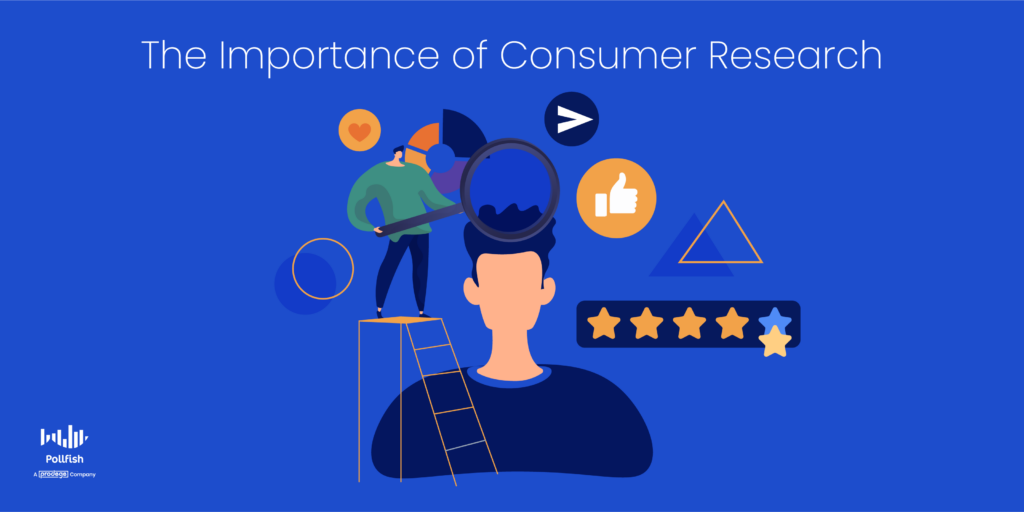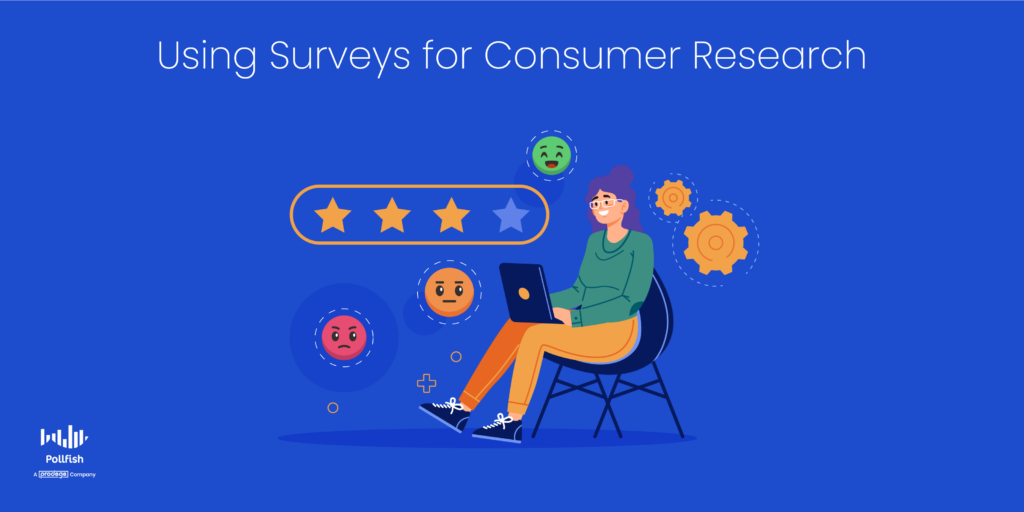Tapping Into Consumer Research Hacks for Your Market Research Campaigns

In today’s digital, mobile-first age where brands are jockeying for customers’ patronage and attention, brands need to conduct consumer research to understand them. This way, they can align themselves with their consumers and excel at serving all of their consumers’ needs.
81% of consumers buy based on their trust in a brand and 77% of consumers buy from brands that share the same values as they do. Clearly, there is much to consumers that businesses must stay aware of, with values and brand trust making up just two of these matters.
However, despite the importance of this kind of research, less than 40% of marketers use consumer research to drive business decisions. This is a problem for various evident reasons, the most important one being the lack of key insights on the population of people who purchase from you.
Many brands simply don’t know how to conduct proper consumer research or don’t have the time to learn how.
This article delves into consumer research, its importance and four key hacks on conducting it to reap quality consumer intelligence.
Understanding Consumer Research
Although consumer research largely makes up the bulk of market research, the two are distinct concepts and shouldn’t be mistaken for one another.
Whereas market research is the all-encompassing practice of studying customers, consumer research is a part of market research that focuses on customer behavior, specifically customer inclinations, motivations and customer buying behavior. In this kind of research, businesses identify these aspects within their target market as a means of studying the psychology behind their customers.
The results of this kind of research allow businesses and organizations to understand their customers on a more granular level. By doing so, they can then create detailed purchasing behavior profiles which they can use to inform all of their marketing campaigns.
There are a variety of consumer research methods to gather this information, which include the overarching approaches of market research techniques. Businesses can use these methods to gain deeper consumer insights, essentially learning about their customers beyond their demographics, location and other outward traits.
Although there are no set-in-stone rules for conducting consumer research, there are several approaches, or hacks you ought to take to hone in on your studies.
This way, you will be able to create well-targeted campaigns on specific consumer segments.
The Importance of Conducting Consumer Research
It’s important to conduct consumer research for a number of reasons.
Consumer research grants you insight into the minds, behaviors, actions and other aspects of the people most inclined to buy from you: your target market. In turn, you’ll have access to in-depth information about your consumers’ desires, needs, expectations and more.
Most importantly, you’ll have access to insights that reveal the “why” behind these phenomena, meaning, you’ll understand the motivations, tendencies and other thought processes that cause your consumers to think and behave in the way that they do.

As such, consumer research provides granular customer intelligence, the kind that allows you to tap into consumer mindsets.
By obtaining this kind of information, businesses can craft tailored marketing personalization and a host of other marketing strategies, including those that make up the strategic planning process.
Unlike strategies and campaigns built on intuition or secondary market research alone, those conducted via primary consumer research provide quality data for decision making — and not just any data that you can easily extract from online sources, but data that is unique, timely and most relevant to your particular target market.
In turn, businesses will be able to form campaigns that don’t merely win over existing customers, but acquire new ones. When you are able to successfully acquire new customers by understanding them on a deeper level, you’ll be able to lower your customer acquisition cost.
By understanding what customers want and how they think, you’ll establish a customer-centric brand in practice as opposed to in theory alone.
You’ll thereby increase your customer satisfaction and keep your brand relevant. As such, you’ll be poised to retain your customers, which is a stronger long-term strategy in comparison to acquiring new customers. This will allow you to increase your customer retention rate, keeping a steady source of customers and the profits they yield.
All in all, consumer research provides the necessary intelligence to win over customers, build consumer loyalty and retain customers, as well as boost your business overall.
Consumer Research Hacks
As aforementioned, there is no hard and fast rule when it comes to conducting consumer research. No technique or set of techniques is set in stone. As a marketer, business owner or market researcher, it is up to you to settle on the methods of running consumer research.
This can be difficult to execute, as there are so many tools and sources available, from secondary sources such as statistics websites and trade magazines, to primary methods such as using a focus group or types of consumer surveys.
Aside from research sources, there are also different research approaches, market research campaigns and types of research you can conduct to learn about the psychology behind your customers. To wade the seemingly difficult waters of consumer research, we’ve laid out four major hacks for conducting consumer research.
The following explains these hacks:
Hack 1: Decide on the Broader Campaign
While there are going to be times in which you simply need to learn how your target market ticks in terms of its consumer preferences and behaviors. However, most of the time, your curiosities about your consumers will not be for stand-alone affairs.
Instead, you may need to collect some in-depth information on how consumers would react to a certain advertisement. You may want to see how they receive emotional marketing, as personality types within your target market will vary.
As such, you should first find the anchoring campaign behind your consumer research. Perhaps it is for a campaign that is already currently running, such as an ad campaign you’d like to A/B test.
Or perhaps, before you embark on another marketing campaign, you seek to gain consumer insights before running it at all. For example, a campaign with a new theme and you need to discover how your customers feel about it.
Come up with your questions or the subject of the questions, at the very least, to guide you and tether your research to a broader business campaign.
Hack 2: Determine the Length and Duration of Your Study
After you tie your consumer research endeavor to an existing or new campaign or undertaking, determine the length and duration of your study. This involves choosing to run another major type of sub-campaign of market research, as certain studies are organized due to their time dependence.
For example, for longer-term consumer research, you may need to conduct longitudinal studies, which aim to gather data on the same set of respondents over a longer period of time. This can last between months and decades.
For short-term consumer research, you may want to conduct cross-sectional studies, in which researchers gather research on a targeted population at one fixed point in time. This type of survey research method is known as being a snapshot of a studied population.
Perhaps you’re interested in studying your consumers’ past habits and experiences. For such a study, you would need to form a retrospective study. Such a study is useful for observing the changes your consumers have undergone, along with picking up on patterns.
Hack 3: Conducting Market Segmentation
The makeup of a target market can be vast, no matter how niche your company and product(s) are. From different age groups, to behavioral aspects, your target market is not composed of a single entity. Rather, it is made up of smaller groups, known as market segments.
It is crucial to conduct market segmentation when executing your consumer research project. This way, you’ll be able to identify the various market segments making up your target market and target them accordingly. Additionally, you ought to segment your target market even further by organizing your segments into customer personas.
These are fictional characters that represent real people in your market segments, except they contain traits that are far more specific than that of a market segment. Personas usually include hobbies and lifestyle aspects. You can then label your different customers by their relation and fit with your personas. Personas allow you to make your messaging even more targeted and satisfy various personalities.
Hack 4: Use a Mixed Style and Multi-Pronged Research Approach
A multi-pronged approach when it comes to conducting and analyzing your consumer research involves using a strong online market research platform. Such a platform should allow you to conduct research via a number of survey types and question formats.
The platform you use should also offer a variety of options for filtering data that you collected, so that it is easy to view and parse. As such, a mixed style involves running multiple kinds of surveys to multiple audiences and relying on numerous kinds of data visualizations.
Variety is important, as different team members aren’t all going to favor the same method of collecting or viewing data. As such, a market research platform that offers a multi-pronged approach to collecting, viewing, exporting and analyzing the data fosters a culture of data democratization, allowing all members of your team to easily take part in consumer research and analysis.
Using Survey Research to Tap Into Consumer Research Hacks
It can be difficult to conduct the proper consumer research with so many sources of information at your disposal. Keep in mind that many of these sources can have dubious or outdated information, rendering your research efforts worse off than they would have been had you never used them.

This is not just a caveat for conducting secondary research via online and offline sources, as certain market research techniques, such as using syndicated research can also be faulty. Although syndicated research can provide you with fresh and original research, it is at the helm of the market research firm conducting the study. Therefore, the firm is in control of how the consumer research study is set up, from its duration to the types of survey questions used.
Instead, you should conduct your own consumer research by using an online survey platform that facilitates the process of creating a DIY survey. Given that online surveys are one of the fastest, affordable and most reliable methods of conducting research, you’d be remiss not to use them for conducting consumer research.
A strong online survey platform grants you quick access to your desired target market sample, extracts data quickly and disqualifies low-quality data.
Delivering the Best for Your Target Market
To deliver the best products, services and CX for your consumers, you need to understand them at a deep level. As such, their age, gender and location alone are superficial aspects in comparison to their behaviors, opinions, needs, sentiments, aversions and more.
In order to tap into all of these consumer aspects, you’ll need to conduct survey campaigns through a potent online survey platform. Such a platform should run on random device engagement (RDE) sampling, which enables you to reach consumers in their natural digital environments, instead of pre-recruiting them. This removes social pressures and will cut back on biases.
You should also use a mobile-first platform, since mobile dominates the digital space.
The platform you select should also offer artificial intelligence and machine learning to remove low-quality data, offer a broad range of survey and question types and disqualify unattentive respondents.
Most importantly, it should allow you to survey anyone. As such, you’ll need a platform with a reach to millions of consumers, along with one that offers the Distribution Link feature.
This feature will allow you to send your survey to specific customers, instead of just deploying them across a network.
When you use an online survey platform with all of these capabilities, you’ll be able to perform quality consumer research.
Pollfish Marketing Team
Ready to Try Pollfish?
Create your survey with AI, target high-quality respondents starting at $0.95 per complete, and start getting results in just minutes in real-time. From running a simple product concept survey to managing a constant stream of trackers for dozens of clients in dozens of countries, we’ve got you.
